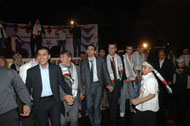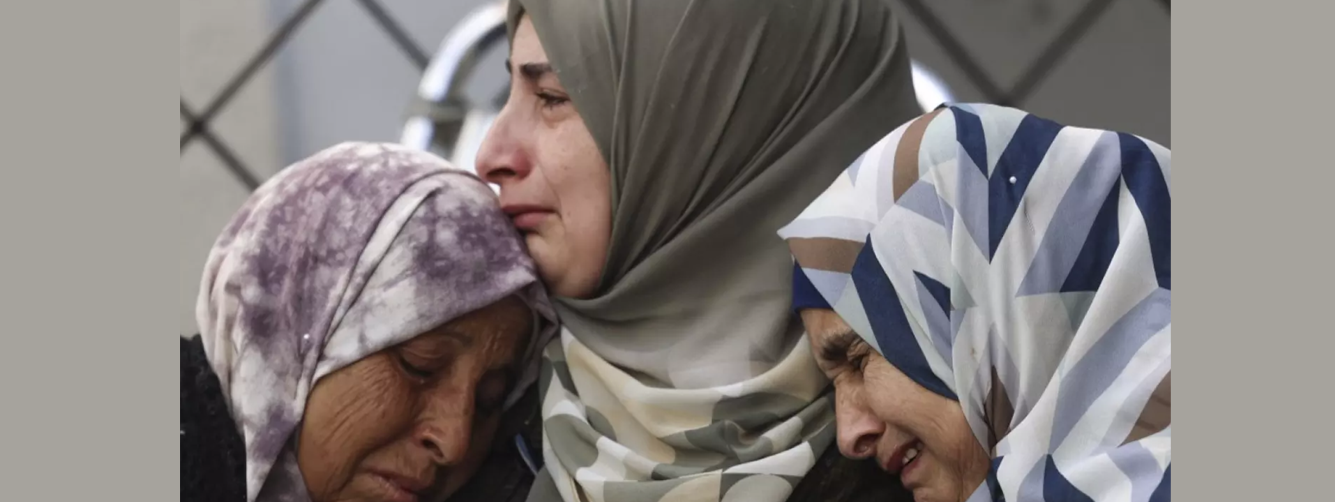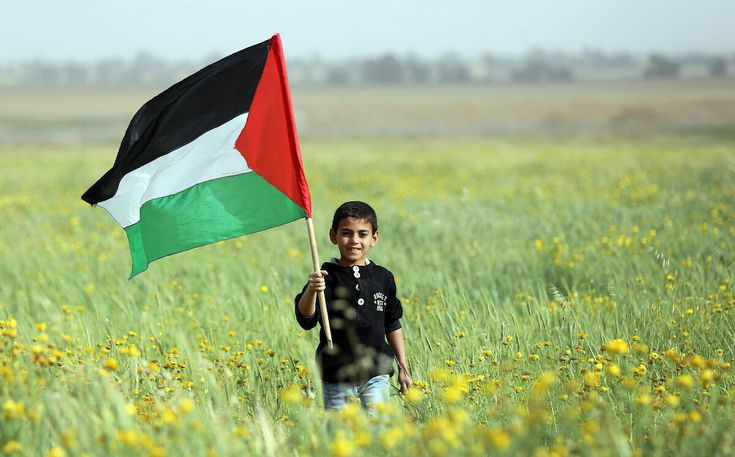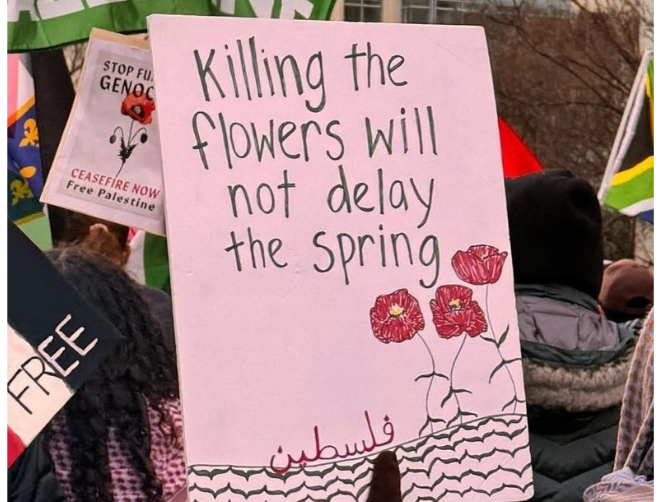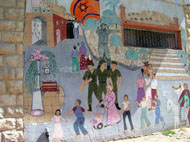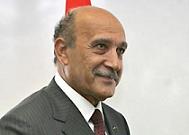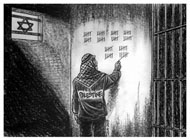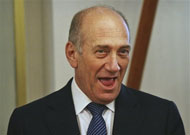The symbolism of marriage is universally congruous across different social and belief systems – it is the process and ritual of this special personal and collective experience that differs. Palestine is no exception.
Last week I attended the wedding of a friend’s brother in Ramallah. The event was a traditional Muslim wedding celebration for the groom, the Middle Eastern equivalent of a “stag” night where the groom commemorates his introduction into manhood with the male members of his family and his male peers. Unlike a western “stag” night which is predominantly viewed as one last night of freedom before the responsibilities of marriage begin and traditionally consists of vast quantities of alcohol as well as ogling women, a Muslim “ehtifal” is alcohol free with not a woman in sight. These omissions, however, do not make the party any less energetic or atmospheric.
Walking into the hotel function room amidst unfamiliar surroundings, I was amazed by the flamboyance of such an affair. My fellow international friends and I were met at the entrance by my friend’s uncle who welcomed us to the party and to whom we passed on our congratulations. I initially inspected the décor of the hall with seats draped in white covers all facing towards the stage alongside tables sporting ash trays (to accommodate the multitude of smokers), soft drinks and nammourah cake. The arched gateway to the dance floor was adorned with colorful red and white flowers which led to two elaborately designed chairs standing on an elevated position in the middle of the dance floor, almost like thrones, one reserved for the man of the hour and the other to accommodate his distinguished guests in rotation.
Through the arched portal to the dance floor I spotted my friend, a man whose generosity, eloquence and sense of humor bridge any kind of cultural or political differences that may exist between us. Expertly parading around the floor, obviously well versed in the art of dabke, he politely welcomed every new arrival personally and excitingly urged them onto the floor to dance around his brother. Despite thriving in his new found role (it is the father who normally performs this service), it no doubt reminded him that his parents and sister are still trapped in Gaza. Nevertheless, my friend could hardly contain his joy and pride in his younger brother coming of age. Having spotted us, he stopped shaking his shoulders to the pounding Palestinian music and ran over to greet us, wiping droplets of sweat from his brow caused by his vigorous dancing.
After I had embarrassingly indulged in a spot of dabke myself, mainly to join in the festivities and please my friend, I took a seat, preferring to let the Palestinians give the music the justice it deserved. While thoroughly enjoying my nammourah, I made an observation which I was surprised I hadn’t made before. There were about 100 men of all ages at this party but a number of them remained seated throughout, choosing instead to be spectators and joining in by clapping their hands. I was wondering whether it was an age factor, but their ages varied, or something to do with status but even if it were, surely celebration dispenses with such formalities.
It was only when two young men, who must have been in their early to mid twenties, were pushed into the room on wheelchairs that I saw the reason as to why more men were not dancing. One of the young men had no legs while the only leg the other one had was prosthetic.
The two were extended a hero’s welcome with the groom rushing to the front to hug them both while others lifted them onto chairs and carried them around the dance floor. It was during this display that I noticed guests swirling walking sticks in the air in appreciation of the two. Approximately 15 men in the hall either had prosthetic legs, walking sticks, crutches or were in wheelchairs. Slightly bemused with who the subjects of attention were, I turned to another Palestinian friend of mine who informed me that most of the people at the party were Fateh soldiers lucky enough to have escaped from Gaza in June 2007. The two in question, along with the other paralyzed men, had been captured by Hamas during the battle for Gaza in June 2007 and had suffered from a technique reportedly utilized by some branches within Hamas to ensure that the Fateh soldiers are never able to serve in the army again. Having been in Ramallah since June 2007, I had heard that these sub-factions of Hamas would either push the victim’s leg to his chest and shoot him in the knee or would line their “enemies” up with their hands on the wall and fire into the backs of their legs, essentially maiming them for life. In all honesty, I originally thought that such stories were embellished and simply reflected the feelings of Fateh personnel disgruntled and infuriated at being defeated by Hamas in Gaza. My hope that an occupied people, already experiencing insurmountable obstacles, would not turn on each other blinded me from the belief that Palestinians could employ such techniques on both sides.
The wedding was the first time I was exposed to stories that transcended into the realms of surrealism for me, but were a living reality for them. The horrific scenes these young men must have imprinted onto the archives of their memory, replayed incessantly, the psychological distress involved in carrying a constant reminder of their past, the stealing of their youth and their future as well as the hatred and contempt stirred by such acts between Palestinian brothers, and the fact that these men were my age, jolted me out of the safety of political analyses at a distance and theoretical notions of solutions and into another dimension of the struggle for peace – the huge task of reconciling the maiming of life, the living symbol of dismemberment of a people by its occupiers and now by its own people.
These atrocities were not only inflicted on Fateh by Hamas. Prior to June 2007, similar splinter groups within Fateh were said, most recently in an article by David Rose for Vanity Fair, to have suppressed Hamas uprisings in Gaza by imprisoning Hamas members and in some instances torturing them. So for every Fateh man proclaiming the barbaric nature of Hamas, there are invariably Hamas men declaring the brutal measures used by Fateh against them before.
Having suffered so much pain, trauma, loss and betrayal can Fateh and Hamas simply forgive and forget?
The signatories on the Sana’a Declaration in Yemen are evidently optimistic. On March 23, Hamas negotiator Moussa Abu Marzouk and Fateh official Azzam al-Ahmed, presided over by Yemeni President Ali Abdullah Saleh, agreed to resume dialogue between the two parties, promote the “unity of the Palestinian people, territory and authority” and return the Palestinian situation to what it was before the Gaza incidents, as stipulated in the Mecca agreement of March 2007. However, the document has raised the same old argument over conditions for dialogue, effectively the result of expecting two seemingly low ranking officials to construct a truce. While Hamas advocates unconditional dialogue, President Abbas maintains that talks can only be had after Hamas relinquishes control of Gaza.
The stalemate continues. Hamas will not concede its only bargaining chip while Abbas fears an Israeli backlash on peace efforts if dialogue with Hamas is established.
The wedding, usually an experience which unites people, represented a microcosmic bubble of the deep rooted issues and divisions between Fateh and Hamas. It reinforced the notion that the boardrooms are greatly removed from the conditions on the ground or the opinion of the people, particularly the soldiers. Some would argue that part of the universal soldier’s lot is that his suffering is forgotten or seen as a necessary sacrifice when peace is eventually reached. In the case of Palestine, with a common enemy already, this is less like the universal soldier and more like betrayal of one section of forces against the other. It is this betrayal which constitutes the barrier to reconciliation, that much as they might have tried not to, they have, as many observers have stated, in such conditions of occupation, frustrated at the power of the occupier, turned quite viciously on each other, these their own people, born of the same soil, of the same blood.
It is clear that Fateh and Hamas must eventually learn to co-exist as both hold significant support from the Palestinian electorate with no viable third alternative. What Palestine needs and what it desperately lacks is an inspirational leader who is respected, who can appeal to both factions, carry them through this division and help them recollect the reason for their struggle.
This week, the imprisoned Fateh leader Marwan Barghouti, revealed that he expects not only to be released, but to win the elections after Abbas steps aside. Can this man, the proclaimed “Palestinian Mandela” rise to the challenge? After all, he is hugely revered amongst the Fateh faithful and Hamas has placed his name at the top of the list in the event of any prisoner exchange with Israeli soldier Gilad Schalit.
At weddings in Palestine, the guests occasionally fire guns into the air in celebration. This, regrettably for the Palestinians at the wedding I attended, is no longer permitted since Prime Minister Salam Fayyad reinforced a law which bans this activity as it places Palestinians at risk. If a venerated leader does not come to the forefront to breech this divide or if a mutual decision cannot be reached, the PA may not be able to prevent gunfire from returning to the streets.




